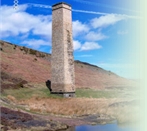The Industrial Archaeology and History of the Clydach Gorge
Click on the button to go to :-
Click on the thumbnail to enlarge a photo or map and sometimes read more about it.
Then click 'Full Size' on the toolbar to see it in all its glory.
The Llammarch Tramroad
The Brecon and Abergavenny Canal Co had constructed a railroad from Clydach Ironworks to Gellifelen and Llammarch in 1794-5. This was converted to a tramroad in 1804 and extended to the canal at Gilwern in 1809. The Clydach Ironworks were not happy with the existing route so re-constructed the tramroad on an easier alignment in 1811 at their own expense. By the 1860s the ironworks was in heavy debt and the B & A took over the works, soon selling it on where it continued to be in financial straits until 1877, when it closed for good. This was the end of the main Llammarch Tramroad but a small amount of trafic was generated by Llanelly Forge for the canal until 1884 when the forge closed too.
Gellifelen and its collieries
Cwm Nant Gam and Gellifelen
The furthest extent of the Llammarch Tramroad appears to have been at the levels above Cwm Nant Gam at SO 2082 1209. This is the end of the lane from Gellifelen which hugs the contour on very easy curves though it may not have got much further West than the lower coal levels at SO 2141 1205. Between these points, the Clydach Railroad branch from Pont Harri Issac climbed to the middle coal levels and would have had to cross the tramroad. which would have been an awkward level crossing.

Cwm Nant Gam and Gellifelen
|

From Cwm Nant Gam old levels
|

From Cwm Nant Gam old levels
|

Tramroad and Railroad crossing
|

Tramroad and Railroad crossing
|

Llammarch Tramroad
|

Llammarch Tramroad
|

Llammarch Tramroad
|
Gellifelen Collieries - SO 2145 1200
Three distinct levels of tips can be found here, the lower and middle tips would be connected to the Llammarch Tramroad and the Clydach Railroad but the large upper tips must have connected with a tramroad at a higher level.

Gellifelen Colliery, the three tips
|

Gellifelen Colliery, the three tips
|

Colliery middle and lower tips
|
|

Gellifelen Colliery, middle tips
|

Gellifelen Colliery, middle tips
|

Gellifelen Colliery, middle tips
|
|

Gellifelen Colliery, middle tips
|

Gellifelen Colliery, middle tips
|

Gellifelen Colliery, middle tips
|

Gellifelen Colliery, middle tips
|

Gellifelen Colliery, upper tips
|

Gellifelen Colliery, upper tips
|
|
|

Gellifelen Colliery, upper tips
|

Gellifelen Colliery, upper tips
|

Gellifelen Colliery, upper tips
|

Mainline next to tramroad
|
Gellifelen Colliery culvert - SO 2144 1207
The Western end of the Gelli-felen tunnels has a culvert alongside it. Likely built as a drainage level for Gellifelen Colliery, it probably passed under Baileys Tramroad through a simple culvert but the LNWR appear to have built a new exit allowing the outflow down an open gutter and under the new line.

Gellifelen Colliery drainage level
|

Gellifelen Colliery drainage level
|

Gellifelen Colliery drainage level
|

Gellifelen Colliery drainage level
|

Gellifelen Colliery drainage level
|

Gellifelen Colliery drainage level
|

Gellifelen Colliery drainage level
|

Gellifelen Colliery drainage level
|
Clydach Ironworks
Clydach Ironworks - SO 2288 1322
Clydach Ironworks was up and running in 1793 with a second furnace in 1797. A third furnace followed in 1826 and a fourth in 1843 and over 1350 people were employed in 1841 by the works and its' suppliers. But by 1861 the furnaces were cold and have remained so ever since though they were listed as assets until 1873. The remains of the ironworks were excavated and conserved in the 1980s. The rolling mills were above the furnaces, where Dan-y-coed is now, and they had been converted to a woollen mill by 1905.The 1795 and 1811 inclines of the Llammarch Tramroad met at the rolling mills and then came down the incline to the West of the ironworks to run across the the front of the furnaces and on down the valley to the canal.

Clydach Ironworks, 1979
|

Clydach Ironworks
|

Clydach Ironworks
|

Clydach Ironworks
|

Furnace No 3
|

Furnaces 2 and 1
|

Furnace No 2
|

Between furnaces 2 and 1
|

Clydach furnace No 2
|

Clydach furnace No 2
|

Clydach furnace No 2
|

Clydach furnace No 1
|

Blastpipe behind the furnaces
|

Behind the furnaces
|

Behind the furnaces
|

Behind the furnaces
|

Clydach Ironworks waterwheel
|

Ironworks from the higher level
|

Ironworks from the higher level
|

Ironworks from the higher level
|
Smarts Bridge - SO 2287 1327
Upper bridge - SO 2292 1333
Lower bridge - SO 2328 1373
Smarts Bridge and one or two tramroads? Smarts Bridge, cast in iron and dated 1824, appears to be for road traffic but it may have carried a spur of the tramroad. The stone bridge just below it may have been either a link to the Clydach Railroad or possibly an 1811 route of the Llammarch Tramroad avoiding the slag bank. The 1799 tramroad ran from the furnaces, behind the slag heaps and over the lower bridge on to Gilwern. Or, of course, all of the above at one time or another. The lower bridge is likely to disappear with the A465 dual carriageway project.

Smarts bridge, Clydach, 1824
|

Smarts bridge, Clydach, 1824
|

Smarts bridge, Clydach, 1824
|

Smarts bridge, Clydach, 1824
|

Smarts bridge, Clydach, 1824
|

Smarts bridge, Clydach, 1824
|
|
|
Clydach brickworks - SO 2320 1365
A brickworks, very likely supplying the ironworks, was in production in 1802 when it was drawn by Amelia de Suffren, a French lady touring Wales. It's marked on the 1843 Tithe Map as occupied by the Clydach Iron and Coal Co. By the 1880 OS map it has gone but nearby buildings remain.

Clydach brickworks, 1843
|

Clydach brickworks, 1843
|

'Clydach brickworks', 1802
|
|
Llanelly Furnace to Gilwern
From Clydach Ironworks to Llanelly Forge
Two routes left Clydach Ironworks, the main Llammarch Tramroad on to Gilwern and, at one time, a railroad branch up to the Clydach Railroad at the 'Bellevue Inn'.

Upper tramroad bridge, West side
|

Upper tramroad bridge, East side
|

Llammarch Tramroad looking East
|
|

Lower tramroad bridge
|

Lower tramroad bridge, West side
|
|
|
Llanelly Furnace - SO 2329 1386
Llanelly Forge - SO 2354 1406
Both Llanelly Blast Furnace and the adjacent Llanelly Forge have completely disappeared leaving just empty spaces. Llanelly Furnace was first mentioned in 1590 and was in full production by 1684. It had fallen into disuse by c1850.
The area also has the site of an early 19th century Tinworks (at Forge House), a separate venture from the forge and furnace, operated as the Llanelly Iron & Tinplate Co during the 1870s and later the Llanelly Tinplate Co. before closure in 1884.
The Forge processed the cast iron into wrought iron until the closure of the furnace, Afterwards the site was used to produce tinplate by the Llanelly Iron & Tinplate Co during the 1870s and later the Llanelly Tinplate Co but this too closed in 1884. The large retaining wall to the North was the forge dam wall which is crossed by a public footpath. Llanelly Forge House is now a private house, this was once part of the Forge complex and then part of the tinplating works. The bridge over the river to the side carried a spur of the Llammarch Tramroad which led to stables on the South bank. The row of cottages, much rebuilt, were the workers accommodation.

Llanelly Furnace and Forge
|

Llanelly Furnace and Forge, 1779
|

Llanelly Forge
|
|

Tramroad approaching the furnace
|

Tramroad approaching the furnace
|

The site of Llanelly Furnace
|

The site of Llanelly Furnace
|

Tramroad approaching the Forge
|

Tramroad at Forge Row
|

Forge Row
|

Llanelly Forge Row
|

Llanelly Forge site in 2010
|

Llanelly Forge pond
|

Llanelly Forge dam
|

Llanelly Forge dam
|

Llanelly Forge dam
|

Llanelly Forge dam
|

Llanelly Forge dam
|

Llanelly Forge
|

Llanelly Forge House
|

Llanelly Forge House
|

Llanelly Forge 'dram'
|
|
Llammarch Tramroad from Llanelly Furnace to Gilwern
The Llammarch Tramroad travels along the banks of the Clydach River to Clydach Wharf and dock on the Brecon and Abergavenny Canal at Gilwern.

The route to Gilwern
|

The route to Gilwern
|

A tramroad culvert
|

The route to Gilwern
|

The route to Gilwern
|

The route to Gilwern
|

The route to Gilwern
|
|

Llammarch Tramroad sleepers
|

Llammarch Tramroad sleepers
|

Llanmarch tramroad sleeper
|
|
Gilwern dock - SO 2435 1451
Llammarch Tramroad runs alongside the river from the A465 junction, past Llanelly Forge and ends at Clydach Wharf and dock, Gilwern. The route is very pleasent footpath with a number of stone tramroad sleepers to be seen. The dock is now used as a boat hire centre but the course of the canalside tramroads is clear. The buildings here are believed to be later constructions.

Tramroads at Gilwern Wharf
|

The Clydach Railroad crossing
|

The Clydach Railroad crossing
|

The Clydach Railroad crossing
|

Clydach Wharf dock
|

Clydach Wharf dock, Gilwern
|

Clydach Wharf
|

Clydach Wharf
|

Clydach Wharf, Gilwern
|

Clydach Wharf, Gilwern
|

Clydach Wharf, Gilwern
|
|
Acknowledgments, sources and further reading.
Thanks to :- Chris George, Richard Preece, Martin Sims and Brynmawr Historical Society for their photos and information.
'The Tramroads of the Brecknock and Abergavenny Canal' by Gordon Rattenbury
'Early Limestone Railways' by John van Laun
A Guide to the Website
Industrial Wales
Collieries, Ironworks, Quarries, Railways, Canals, Tramroads, Tunnels, Culverts and so much more....
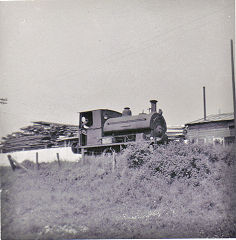
|
Brickworks of Wales
Bricks are 'History with a label' so here's the story of the Brickworks of Wales - photos, maps and the products themselves
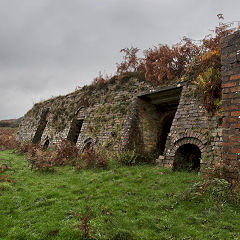
|
Around the World
My travels around the UK and the Whole Wide World in search of industries, railways, trams and mines to name a few.
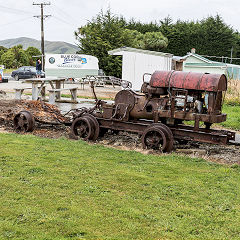
|
Boundary Stones and Mileposts
Boundary Stones, Mileposts and other markers in simple alphabetical order of their initials, name or site.
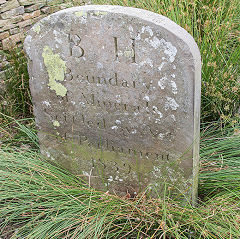
|
Ships and Shipping
Ships around the World in simple alphabetical order of their name (or apparent area if I can't read the name).
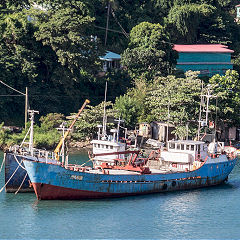
|
The Site Map and Index
A full list of all the pages of the whole website in just one place, so you should find exactly what you are looking for.
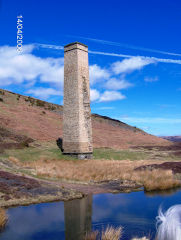
|
About the Site
The background and technical details about the site, plus a contact page and links to other sites - and a warning !!
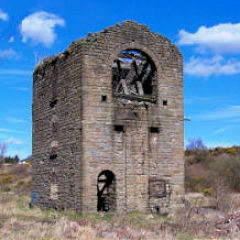
|
Contact Me
Something to add? A great photo? Something wrong? or need to know more about things? Just drop me a line here.

|
Further Reading
You can find lots of local and other very helpful websites, books, magazines and Facebook groups all listed here.
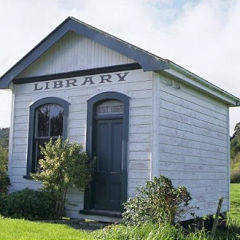
|
All rights reserved - Phil Jenkins
